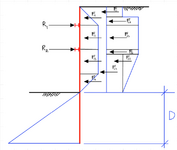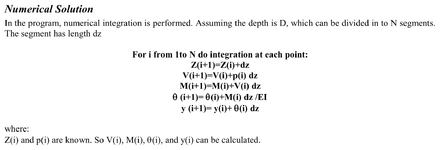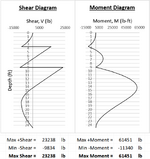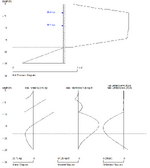Anyone familiar with the Shoring Module and their methodology to come up with the Slope for Soldier Pile? I am checking their output and I want to make sure I can get the same answers myself. However I am running into some trouble coming up with the same slope (and in turn, deflection).
Using the Hinge-Method for soldier pile with multiple braces (per CalTrans) I was able to come up with the same reactions and embedment depth as the program.

For shear, moment, slope and deflection, the program uses the double-integration method (which is the same as finding area under the curves).
Since some of the loading gets complicated (such as the Boussinesq loading curve), integrating those equations at multiple segments gets quite hairy so I used the trapezoidal rule with small segments to approximate. Results for shear and moment were very close as you can see.


My trouble is going from the moment curve to the slope. There isn't a location along the depth were I can comfortably predict that the slope would be 0 as my starting point. And no, it isn't at where the moment is max.
This has been bugging the hell outa me. Any help is much appreciated.
Using the Hinge-Method for soldier pile with multiple braces (per CalTrans) I was able to come up with the same reactions and embedment depth as the program.

For shear, moment, slope and deflection, the program uses the double-integration method (which is the same as finding area under the curves).

Since some of the loading gets complicated (such as the Boussinesq loading curve), integrating those equations at multiple segments gets quite hairy so I used the trapezoidal rule with small segments to approximate. Results for shear and moment were very close as you can see.


My trouble is going from the moment curve to the slope. There isn't a location along the depth were I can comfortably predict that the slope would be 0 as my starting point. And no, it isn't at where the moment is max.
This has been bugging the hell outa me. Any help is much appreciated.
